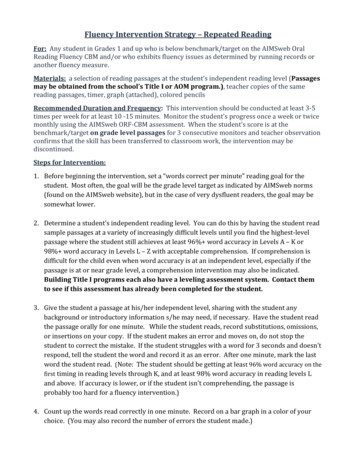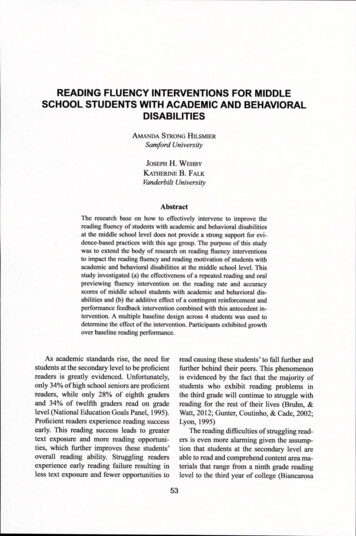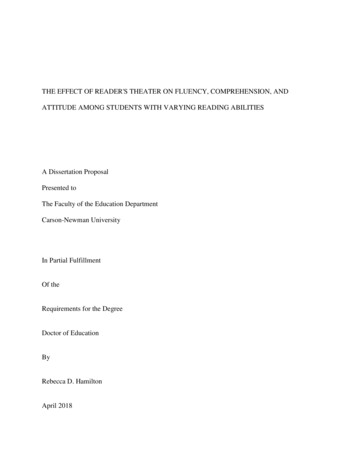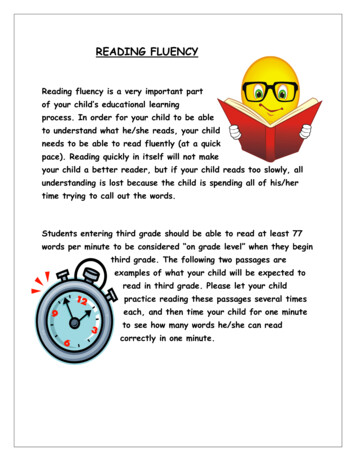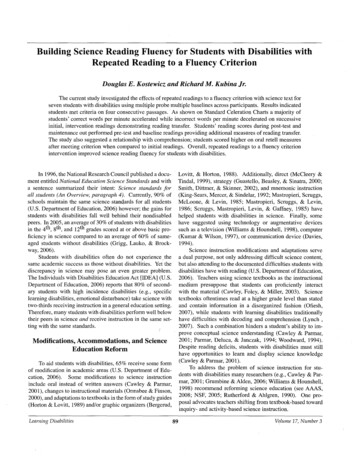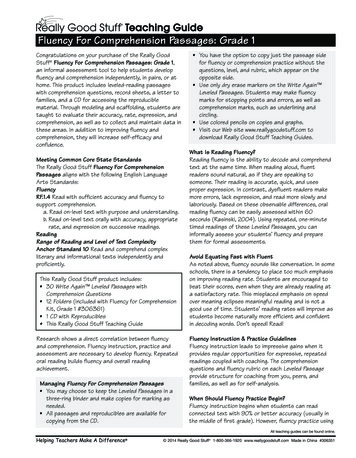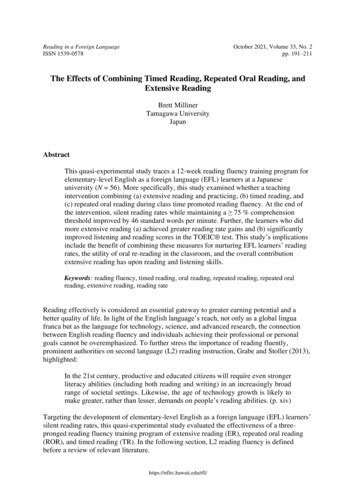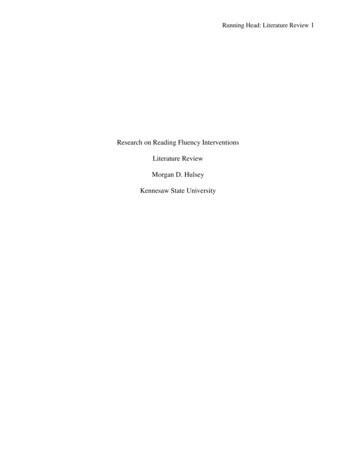
Transcription
Running Head: Literature Review 1Research on Reading Fluency InterventionsLiterature ReviewMorgan D. HulseyKennesaw State University
Running Head: Literature Review 2AbstractReading plays such an important role in a child’s education. Reading is made up of fivemajor components including phonics, phonemic awareness, fluency, comprehension, andvocabulary. In order to become effective readers, children must have quality instruction in all ofthe five component areas. The purpose of this literature review is to investigate the mosteffective methods of fluency intervention as well as the connection between reading fluency andcomprehension. The research included in this paper discuses several fluency interventions andvarious way to implement them. The paper also describes how reading fluency and prosody canaffect comprehension.
Running Head: Literature Review 3Reading is an essential part of learning and education. Reading is vitally importantbecause it affects many other areas of learning. When students begin their education they beginlearning how to read. The student will spend multiple years on learning how to read. Once astudent reaches a certain point in their education a shift takes place in reading. Up until this pointthe student has been focusing on learning how to read and improve their reading skills. Once astudent learns how to read a shift occurs in which the student is now reading to learn. At thispoint other subjects require students to use their reading abilities to be successful. Reading ismade up of five reading components: phonics, phonemic awareness, fluency, vocabulary, andcomprehension. Although all five components of reading are important and have been researchedextensively, the purpose of this paper is to explore current research on improving reading fluencythrough multiple interventions and strategies. According to Pressley and Allington (2015)“Fluent reading refers to accurate and fast reading at the word level, with good prosody”(Pressley & Allinton, 2015). Because fluency is such an important component of reading, whenstudents struggle with fluency it is important to provide appropriate interventions. There hasbeen much research performed in the area of fluency interventions. Andersen (2013) performed aresearch study to determine if a one-trial brief experimental analysis would identify effectivemethods to improve oral reading fluency. The participants selected for this study were six thirdgrade students attending two different elementary schools in the Midwest. To complete thestudy, 15 passages were selected for each participant based on the difficulty level determined foreach participant by a pre-experimental screening. The dependent variable in this study was oralreading fluency. There were two types treatments, contingent reward and instruction, that wereused in the One-trial Brief Experimental Analysis (OTBEA) and the extended analysis. A rewardwas given based on the participant meeting a performance goal. Instruction for this study
Running Head: Literature Review 4included “Listening Passage Preview, Repeated Readings, Phase Drill, error correction, andSyllable Segmentation error correction” (Andersen, 2013).The OTBEA was performed in a single session averaging 23 minutes. Participants weregiven directions for selecting their reward to work towards at the beginning of each session. Theinstructional trial included administration of the instructional components. In some assessmentsthe rewards had visual reminders for the students, while in others the reward reminder was onlyverbal from the examiner. When the participants completed the assessment passages, thepassages were scored and if the goal was met the reward was given to the participant. TheExtended Analysis was performed in 3 separate sessions. The first session was reward andinstruction in which the participant chose a reward to earn for this reading, received theinstructional components, completed the assessment passage, and then was given the reward ifthe goal was met. The second section was reward only. The participant chose the reward to worktowards, completed the assessment passage, and received a reward if the goal was met. The thirdsection was control. In this session the examiner verbally informed the participant of the reward,encouraged the participant to do their best, and performed the assessment passage.The results from the OTBEA in this study showed that three participants respondedpositively to the reward and instruction condition. The other three participants wererecommended to receive a performance-based intervention. According to the extended analysis,the reward and instruction condition produced the most consistent results. Which is notsurprising considering this is the stronger condition of the two interventions. The rewardcondition results were more inconsistent. Overall the results suggest that full intervention willconsistently produce better results than a performance-based intervention (Anderson, 2013). Thisstudy is helpful in showing the importance of full intervention programs. Based on the results of
Running Head: Literature Review 5this study, it is important to provide students with full intervention to improve their overallreading performance. The findings of this literature support the need for schools to use more fullintervention programs rather than performance-based intervention in order to meet the needs oftheir students. Further research is needed to verify these results. However, these results doindicate that a potential change in intervention approaches is needful to ensure that studentscontinue to improve their fluency skills.In addition to the research Andersen (2013) performed, other research has been done todetermine the most effective interventions to improve reading fluency. Ring, Barefoot, Avrit,Brown, and Black (2012) conducted a study to compare two reading intervention programs todetermine the effectiveness of these programs on improving reading fluency. This study wasperformed on eighty-eight students in second through fifth grade that met the inclusion criteria.Two of the participants moved out of the school district, therefore, the final sample included 86participants. These participants represent about 25% of the general education population thatwere referred to Tier II reading interventions. Participants’ reading skills were evaluated prior totreatment in the study. The interventions were implemented by 25 classroom teachers. Twelve ofthe teacher implemented text-level instruction as an intervention. The remaining 13 teachers usedword-level treatment. The word-level treatment utilized a published program for readinginstruction. The text-level instruction used materials from a reading fluency program called ReadNaturally. The teachers received training in how to implement each program effectively. Themeasures for this study included growth in reading fluency and accuracy at single word and textlevels. Oral reading fluency was evaluated with the Gray Oral Reading Test (GORT). This testcontains three subtest scales: “Rate, Accuracy, and Comprehension” (Ring, Barefoot, Avrit,Brown, & Black 2012). Isolated word reading efficiency was evaluated using the Test of Word
Running Head: Literature Review 6Reading Efficiency (TOWRE). The test contains two subetests scales: “Sight Word andPhonological Decoding Efficieincy” (Ring, Barefoot, Avrit, Brown, & Black 2012). The researchdesign utilized for this research was a comparative efficacy of the two intervention programs.The programs were evaluated in a “2 X 2 (treatment X Time) randomized-cluster control trial”(Ring, Barefoot, Avrit, Brown, & Black 2012).To analyze the data a doubly multivariate analysis was performed on the GORT and theTOWRE. ANOVA’s were also performed on individual subtests. The results showed mixedsupports. Students from both groups showed slight gains in the areas of timed oral readingaccuracy and rate. The word-level training showed some gains in word reading accuracy, butfailed to show improvements in timed word reading. This study utilized published programs asinterventions. Because there were slight gains in the students’ performance, a different researchstudy design would be helpful in determining the effectiveness of the program versus thepedagogy of the teachers implementing the program. When considering the purchase of thesetypes of intervention programs, it is vital to know the ease of use as well as the effectiveness ofthe actual program.Besides the development of fluency programs there are also several interventionstrategies used to improve reading fluency. One of these strategies is repeated reading. Ardoin,Morena, Binder, and Foster (2013) conducted a research study to determine if repeated readingsalong with feedback could influence prosody. The participants for this study included 38 thirdgrade students and 38 fourth grade students. The students were randomly placed in one of twogroups. One group focused on reading rate, while the other group focused on reading prosody.Due to audio difficulties the recording of five of the participants in each group were unusable.Therefore, reading rate and error results were based on data from 76 participants, but prosody
Running Head: Literature Review 7data is only based on 66 participants. Materials used for this study included an expositorypassage from DIBELS fourth-grade progress monitoring materials, a prosody rating form toprovide prosody feedback, and Praat Version 5.2.26 computer program used to analyze pitch andintensity in spoken language. The dependent variables of this study included oral reading rateand prosody.Each session was audio recorded and lasted approximately 15 minutes. During thesessions, before the initial reading of the passage, students were told to do their best reading. Theexaminers recorded the errors, provided words when a student hesitated for three seconds,recorded the total time for each reading, and gave error correction. Feedback was given based onprosody or reading rate depending on which group was being tested.Overall the results of this study agreed with previous research that repeated readingimproves reading fluency. Results support the research showing the importance of directions andfeedback being given to the students. Students in the group focusing on reading rate improved inall four reading trials. However, the data from the group of students focusing on reading prosodydid not show a significant increase in reading rate. The researcher explains results of the prosodygroup could be due to that fact that these students were already performing at an above averagereading level. In terms of reading prosody, improvements were made, but were mostly dependenton the conditions of the intervention.Phrase drill and listening passage preview have also been studied along with repeatedreading as ways to improve reading prosody. Noltemeyer, Joseph, and Watson (2014) conducteda study comparing three intervention approaches (repeated reading, phrase drill, and listeningpassage preview) to determine their affect on reading prosody. The study was performed on fourstudents, at the end of their second grade year, which were experiencing risk for reading failure.
Running Head: Literature Review 8All of the four participants received exposure to a standards based reading curriculum throughoutthe school district’s summer program. The program curriculum was implemented by the sameinstructor, four days a week. The materials used for this study included second grade readingpassages based on the curriculum. The dependent variables were oral reading prosody and oralreading fluency on passages that had been practiced by the participants. There were threedifferent experimental conditions used in this study. The first condition was repeated reading(RR) 3X. This condition provided multiple opportunities to practice the reading passages. Thesecond condition was repeated reading (RR) and listening passage preview (LPP) in which thepassages were modeled to the participants before reading. This condition still incorporatedmultiple practices and readings of the passage. The third condition was repeated reading (RR)and phrase drill (PD). In this condition the participants were provide with error correction andmultiple practice opportunities.Prior to the intervention the participants were told to read three passages. They weregiven one minute to read each passage. During the reading correct words per minute and prosodywere scored to show whether the passages were the correct reading level for each participant.Over a three week period the treatments were implemented and examined to determine theeffects on prosody. All participants were exposed to each intervention five times. The sessionsgenerally lasted 20 minutes with two interventions per session.All of the data was analyzed using two methods. The first method used visualpresentation of data in which results were graphed and analyzed. In the second method thepercentage of non-overlapping data was calculated in order for baseline prosody levels to becompared to final prosody levels. The results showed that participants 1 and 4 seemed to benefitmost from the repeated reading (RR) plus listening passage preview (LPP). These findings
Running Head: Literature Review 9seemed to support previous research that modeling enhances comprehension. Participants 3 and4 showed considerable overlapping data in oral retell fluency across the experimental conditions.According to the results there were no consistently higher results in the repeated reading (RR)3X condition. Because of the variability in the results it is difficult to draw specific conclusionabout which method is most effective. However, the results do reveal that the individualparticipants responded to the interventions differently. This further supports the need forindividual plans of intervention for each individual student.Because of the various types of strategies for improving reading fluency Casey,Robertson, Williamson, Serio, and Elswick (2011) conducted a case study to assess theeffectiveness of using brief intervention probes based on evidence-based strategies. This casestudy was performed on an eight-year-old female that was identified as having difficulties inreading fluency. The participant had been previously diagnosed with ADHD as well as anauditory and visual processing disorder. Prior to the study the participant was given six weeks ofsmall group tutoring after school. To collect baseline data pre-primer and first-grade readingpassages were used for placement testing. CBM reading probes were adapted from AIMS WebCurriculum-Based Measurement progress monitoring system (Casey, Robertson, Williamson,Serio, & Elswick 2011). According to the baseline data the participant was reading at the preprimer level. Therefore, the interventions were implemented on the pre-primer level. The twointerventions implemented in this case study were repeated reading and listening passagepreview. The dependent variable in this research is the number of words read correctly perminute (WCPM). The design of this case study was an A/B single-subject research design(Casey, Robertson, Williamson, Serio, & Elswick 2011).
Running Head: Literature Review 10At the beginning of this study baseline data was collected from pre-primer and grade 1leveled passages. After baseline data was collected a brief probing of the two interventions wasgiven to determine whether the long-term intervention would be repeated reading or listeningpassage previewing. Repeated reading was the intervention chosen to complete the rest of thecase study due to a significant increase in words read correctly in a minute using thisintervention. The participant would read the same passage for one minute. Once one passage hadbeen read three times, another passage at the same level was given to the participant. The medianscore of word read correctly in a minute was recorded.The results of this case study showed a significant increase in words read correctly perminute. The total increase from the baseline data until the completion of the study was 37 words.Based on the results it seems the use of brief intervention probes can be effective in increasingreading fluency. Although these results are significant, it is needful for further research on alarger sample size of participants. It would also be important to determine the feasibility of thistype of intervention in a classroom setting.Reading fluency is important as it is one of the five components of reading. However, italso serves as a strong building block for comprehension, which is the ultimate goal in reading.Patton, Crosby, Houchins, and Jolivette (2010) conducted research to determine if usingcomprehension strategies along with fluency instruction would be an effective way to improveboth comprehension and fluency. The researchers used the Great Leaps Reading Program whichis designed to help improve reading fluency. In addition to this fluency intervention program,comprehension strategies were added to one of the groups. This study used fourparaprofessionals from the same elementary school as well as the students participating in theresearch. The participants in this study included 59 students in first through third grade. Three of
Running Head: Literature Review 11these students received special education services for speech/language impairment, specifiedlearning disabilities, and other health impairments. The study was performed in a largesoutheastern inner-city school district. The measures used in the study included reading fluencyand reading achievement. The Test of word Reading Efficiency (TOWRE) Sight Word Efficiencyand Phonemic Decoding Efficiency subtest were administered to compute standard scores inreading fluency. The WJ-R III achievement test was used to evaluate reading achievement.To complete the study the paraprofessionals were trained in implementing the GLRProgram with and without comprehension questions. During the intervention the students wererandomly placed into the groups Treatment One or Treatment Two. The participants in bothgroups received interventions for two 10-15 minutes sessions per week for 15 weeks. In thetreatment one group the students received instruction utilizing the GLR Program to improvereading fluency. Students were instructed in phonics, high frequency words, and stories. In theTreatment Two group the students received the same GLR Program interventions withinstruction in phonics, high frequency words, and stories. However, this group also receivedbrief comprehension instruction in which the paraprofessionals administered three oral multiplechoice questions. A pre and post-test of the Woodcock Johnson-R III was performed on theparticipants to measure gains after to implementation of the interventions.To analyze the data a split-plot ANOVA was performed to compare pre and post-test datain terms of “passage comprehension, reading fluency, and broad reading” (Patton, Crosby,Houchins, & Jolivette 2010). A split-plot ANOVA was also performed to compare pre and posttest data in terms of “site word recognition and phonemic decoding” (Patton, Crosby, Houchins,& Jolivette 2010). Based on the results of the study it appears that implementation of acomprehension strategy had a negative impact on reading comprehension of the participants in
Running Head: Literature Review 12this study. Although repeated reading is a proven intervention to help improve reading fluency, itis believed by these researchers that it does not aid the students in using the cognitive processesneeded for comprehending text. The researchers do mention the fact that the lack of automaticitycould be related to an inability to comprehend text (Patton, Crosby, Houchins, & Jolivette 2010).This study shows that repeated reading is an effective intervention to improve reading fluency.However, it also demonstrates that it is not a “fix all” strategy. In order to improve overallreading performance other strategies may need to be implemented to address other problemareas.Other studies have also been performed to determine if comprehension can be improvedby improving reading fluency. Neddenriep, Fritz, and Carrier (2010) performed research todetermine how reading fluency interventions would affect comprehension. This study assessedfive fourth grade students over a fifteen week period using evidenced-based instructionalcomponents for reading fluency.The participants of this study were students in general education at an elementary schoolin the Midwestern United States (Neddenriep, Fritz, & Carrier 2010). The students were chosenby their teachers based on fall benchmarks assessment data. According to the data these studentswere considered to be reading at the frustration level. All of these students were performingbelow the 25th percentile. These students were not receiving any additional interventionsservices. The materials used by the researchers included AIMSweb R-CBM and Maze passages(Neddenriep, Fritz, & Carrier 2010). These resources came from the AIMSweb ProgressMonitoring and RtI System and were used to determine the initial reading performance level ofeach student. The resource materials were also used to assess how much impact the readingfluency intervention had on each individual student. Other resources used in this study included
Running Head: Literature Review 13Great Leaps Elementary Program Sight Phrases and Passages. The researchers used threedependent measures to assess reading proficiency (Neddenriep, Fritz, & Carrier 2010). The firstmeasure was oral reading fluency to determine the number of words read correctly per minute.The second measure was the number of errors made per minute. The third measure utilized theMaze passages to determine the number of correct responses per 3 minutes.A brief intervention assessment was also performed to show which instructionalcomponent would be most effective in improving each students’ reading fluency. Theinstructional components included “practice, modeling, error correction, contingentreinforcement, and performance feedback” (Neddenriep, Fritz, & Carrier 2010). Repeatedreading is an intervention which has shown improvements in students’ “speed, accuracy, andunderstanding of the passage read” (Neddenriep, Fritz, & Carrier 2010). This intervention ismost successful when it includes the following components: “the student reads aloud to an adult;the adult corrects errors to ensure accurate practice; and the adult provides feedback regardingperformance to ensure mastery” (Neddenriep, Fritz, & Carrier 2010). During the studyparticipants were given exposure to stacked conditions of “repeated practice, performancefeedback, and error correction following a baseline condition within the brief interventionassessment” (Neddenriep, Fritz, & Carrier 2010). Students practiced by reading the passage threetimes. The students then were given performance feedback in addition to practice in which theywere told how many words they read per minute and then asked to read the passage three times.A comparison or words read per minute was then shown to the students on the same passage.When students were provided with error correction, performance feedback, and practice studentswere informed of mispronounced words and skipped words. The participants were thenprompted to each phrase with the appropriate corrections three times as well as reread the
Running Head: Literature Review 14passage two more times. Once again a comparison of words read per minute was given to thestudents. Four different AIMSweb R-CBM passages were used to assess each condition. Thecorrect words and errors per minute were graphed and compared to the baseline performace levelof each participant. This data was used to determine which components would be most effectivein improving each participants’ performance. After the collection of data using the AIMSwebmeasures or R-CBM and Maze, the same conditions of practice, performance feedback, and errorcorrection were used with the Great Leaps Elementary Program Passages and Sight Phrases.Students were grouped into two pairs and a single student according to their reading levels. Theparticipants worked with three adults for 30 minutes a day, 2 days per week. The interventionslasted 12 weeks. Participants’ progress was monitored and assessed using AIMSweb measures ofR-CBM and Maze.In order to analyze the data from this study, the researchers used single-case designs.These designs demonstrated a change in fluency over time as well as evaluated changes incomprehension over the same time period. The data was graphed and visually inspected. Thepercentage of change and standardized effects was calculated to show the different betweenbaseline levels and intervention levels. Checklists were also completed to show that theprocedures were implemented with complete integrity during all sessions.The results showed that all five participants increased the number of words read correctlyper minute after receiving performance feedback and practice. When error correction was addedto performance feedback and practice, it led to a higher number of correctly read words perminute. Overall the results showed that during the 12 weeks in which repeated practice,performance feedback, and error correction were implemented participants increased an averageof 25% over the baseline performance levels. Four of the five participants also showed
Running Head: Literature Review 15significant gains in reading comprehension. This research study seems to show the most positiveresults of all the research provided. From these interventions, results show that all of theparticipants improved their reading fluency. Thus these types of strategies should be consideredwhen conducting fluency interventions with students.Research has also been performed to determine how much reading fluency is an indicatoron reading comprehension. Basaran (2013) conducted this study to investigate the relationship ofreading habits, conditions, and situations in regards to comprehension. This was a quantitativeresearch study of 90 fourth grade students during the 2012-2013 academic year. These fourthgrades were students in state primary schools in Kutahya. To begin the study each student wasgiven four separate tests. The first test was a fill in the blank test. This was given to measurereading as a process. The second test given was a short answer test to determine how much thestudents remembered. The third test was a multiple choice test to measure superficial in-depthmeaning linking as well as open-ended questions to measure meaning linking skills. The finaltest had each student read the text “Chest” aloud. The voice recordings were then analyzed bythree field experts in reading fluency. The experts identified reading speeds and mistakes of eachstudent. Prosody was also evaluated and calculated by the experts. If there were differences inthe scoring, the students recording would be listened to again. Upon listening to the recording, ageneral consensus would be reached. After the evaluation of all recordings, the results wereloaded into a computer. The Pearson correlation and a multiple regression analysis wereperformed to analyze the data (Basaran, 2013).The results from this study showed the relationship between reading speed and in-depthmeaning linking was minimal (Basaran, 2013). There was a weak correlation between readingspeed and comprehension. However, there was a significant relationship found between reading
Running Head: Literature Review 16prosody and general comprehension, particularly the in-depth meaning linking skills. This studyshows in the terms of the fluency skills of speed, accuracy, and prosody there is a relationshipbetween reading fluency and comprehension.Based on the research concerning fluency intervention, the results have shown variouslevels of effectiveness. However, further research is needed to find the best method of fluencyintervention. In each study conducted on fluency interventions or strategies there were mixedresults about which interventions showed improvements in fluency. It seemed that theeffectiveness of the strategies of interventions depended on the different participants in thestudies. The results seem to demonstrate the importance of individualized interventions. Studentsall have different learning needs, because of these differences it is important for teachers toprovide differentiated instruction and interventions based on each student’s learning needs. Theculture of education is driving the research for differentiation. Many school systems are nowusing differentiated instruction as a component of teacher assessment to ensure that teachers arestriving to meet the individual needs of students. Although there has been research performed inthe areas of reading fluency and differentiation, more research is needed to determine the mosteffective way to implement these strategies. Research is also needed on larger and more diversepopulations to determine true and accurate measures on reading improvements. Although furtherresearch is needed, teachers in today’s classrooms can utilize the research that has beenperformed to help focus their current practices for differentiated instruction in the area of readingfluency.
Running Head: Literature Review 17ReferencesAndersen, M.D. (2013). Examination of a One-Trial Brief Experimental Analysis toIdentifyReading Fluency Interventions. Psychology In The Schools, 50(4), 403-414Ardoin, S., Morena, L., Binder, K., & Foster, T. (2013). Examining the impact of feedback andrepeated readings on oral reading fluency: Let’s not forget prosody. School PsychologyQuarterly, 391-404.Basaran, M. (2013). Reading Fluency as an Indicator of Reading Comprehension. EducationalSciences: Theory & Practice, 13(4), 2287. doi:10.12738/estp.2013.4.1922Casey,
The materials used for this study included second grade reading passages based on the curriculum. The dependent variables were oral reading prosody and oral reading fluency on passages that had been practiced by the participants. There were three different experimental conditions used in this study. The first
